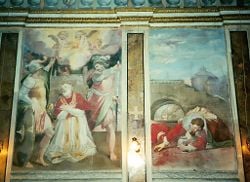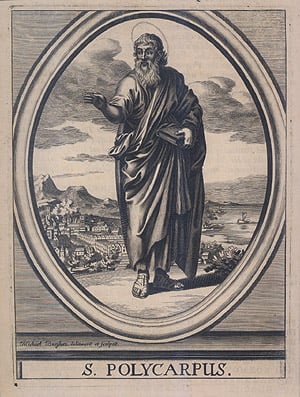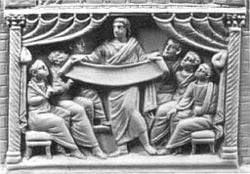Pope Anicetus
| Saint Anicetus | |
|---|---|

| |
| Birth name | Anicetus |
| Papacy began | ca. 154 |
| Papacy ended | ca. April 17, 167 |
| Predecessor | Pius I |
| Successor | Soter |
| Born | ??? Emesa, Syria |
| Died | ca. April 17, 167 Rome, Italy |
Pope Saint Anicetus was bishop of Rome in the mid-second century. In his time, the early papacy began to take on a more definite historical character compared to that of most of his predecessors. Nevertheless, sources vary widely concerning Anicetus' dates, ranging from a beginning date of 150-157 to an ending date of 153-168, with his reign lasting from nine to 11 years.
Anicetus was involved in upholding the Roman tradition of celebrating Easter on Sunday rather than in relation to the day of the Jewish holiday of Passover, although he did not insist that other churches follow the Roman custom. In connection with this issue, he received a visit from the venerable Bishop Polycarp of Smyrna, who supported the Eastern tradition of keeping the Easter feast on the fourteenth day of the Jewish month of Nisan. Another prominent visitor to Anicetus was the Christian historian Hegesippus.
Anicetus may be the pope referred to by Tertullian as initially supporting Montanism but then condemning it as heresy, although Pope Eleutherus is probably a more likely candidate. Anicetus also had to contend with Gnosticism and Marcionism, which were active in Rome during his time. According to the Liber Pontificalis, Anicetus decreed that priests are not allowed to have long hair. Tradition holds that he suffered martyrdom during the reign of the Roman Co-Emperor Lucius Verus. However, today his martyrdom is considered unconfirmed. April 17 is celebrated as his memorial or feast day.
Biography
The name Anicetus is Greek for unconquered. He was a Syrian from the city of Emesa (modern-day Homs). Nothing more is known of his background except that his father's name is given as John.
Dating of Easter
According to the late second-century writer, Bishop Irenaeus of Lyons, the aged Bishop Polycarp of Smyrna visited the Roman church during Anicetus' time. Polycarp, then some 80-years-of-age, was especially honored in the early church, as he had been a disciple of Saint John the Evangelist. Irenaeus relates that the two churchmen found themselves in agreement on all matters then facing the church except the question of the celebration of Easter.
Polycarp's church at Smyrna, together with the other churches of Asia Minor, marked the yearly commemoration on the fourteenth day of the Jewish month of Nisan, which coincides with the Passover. The particular day of the week was not important in the East, which generally followed the tradition of the Gospel of John that Jesus had been crucified on Passover.[1] Although the Roman church did not yet celebrate a special Easter festival, it held that Jesus had been resurrected on a Sunday, and that this day should therefore be considered Easter rather than 14 Nisan. Polycarp attempted to persuade Anicetus of the correctness of the Eastern view, but the two could not reach an agreement. On the other hand, Anicetus made no attempt to pressure the church of Smyrna to adopt the Roman practice.
According to the fourth century writer Eusebius of Caesaria, the Christian historian Saint Hegesippus also visited Rome during Anicetus' pontificate. Although nearly all of Hegesippus' writings are lost, a fragment of his, preserved by Eusebius, indicates that the future Pope Eleutherus was deacon under Anicetus. Hegesippus also mentions his visit to Corinth and other churches on his way to Rome, finding that "in each city all is according to the ordinances of the law and the prophets and the Lord." The visit of Hegesippus is often cited in Catholic tradition as a sign of the early importance of the Roman See. To quote the Catholic Encyclopedia: "His visit is recorded by most ecclesiastical authors as noteworthy, inasmuch as it calls attention to the fact that many illustrious men repaired to Rome at that period, thus emphasizing very early the supreme dignity and authority of the Roman Pontiffs."[2]
Dealing with heresy
Despite Hegessipus' comment that all was well in every church he visited, in Anicetus' time, Christianity in Rome was a diverse and contentious community. Among the famous teachers spreading an alternative version of the Christian message in Rome were Marcion and Valentinus. Marcion had been prominent in the Roman church not only for his teaching but because he was a man of great wealth who had made a large donation to the church. His doctrine, however, held that the Christian God was a completely different deity than the wrathful and legalistic being referred to as the Creator in the Jewish scriptures. Marcion therefore rejected the Hebrew Bible entirely and accepted only an abridged version of the Gospel of Luke and a number of the letters of the Apostle Paul as sacred scripture. Marcion had been excommunicated prior to Anicetus' episcopacy, but his followers now formed a rival congregation which with Anicetus had to contend. No less a problem was Valentinus, the premier Gnostic teacher of his age. Valentinus' mystical philosophy shared with Marcion a belief that the Jewish God was an inferior being to the Heavenly Father of Jesus, but also developed a rich literary and spiritual tradition that attracted many followers. (According to the Liber Pontificalis, Anicetus decreed that priests were not allowed to have long hair, perhaps because the Gnostics wore long hair. However, this decree cannot be historically confirmed.)
The opposite pole to these alternative brands of Christianity was represented by Jewish Christians who insisted strictly on Jesus' humanity (as opposed to his divinity) and continued to practice Jewish customs like circumcision and kosher dietary laws.
Finally, there were the Montanists, at the time a group still within the "orthodox" Christian community, who spoke in tongues, believed in continuing revelation though prophecy, and urged the church to a strict asceticism in preparation for the imminent Second Coming of Christ. Anicetus may have been the first Roman bishop to condemn Montanism as heresy. However, many believe it was actually a successor, Eleutherus, who was the pope that first condemned the Montanists. Tertullian, the source of our information on this point and a Montanist himself, is not specific in his reference:
For after the bishop of Rome had acknowledged the prophetic gifts of Montanus, Prisca, and Maximilla, and, in consequence of the acknowledgment, had bestowed his peace on the churches of Asia and Phrygia, he, [Praxeas], by importunately urging false accusations against the prophets themselves and their churches… compelled him to recall the pacific letter which he had issued, as well as to desist from his purpose of acknowledging the said gifts.
Whoever this pope was, the passage gives a clear impression that at one time Montanism was not only tolerated but even encouraged by him. The popularity of Montanism in Asia Minor is also apparent. Indeed, Anecitus' tolerant attitude toward Bishop Polycarp with regard to the Easter question may have been motivated in part by a recognition that to force the issue would have resulted in alienating the Christians of the region and thus furthering the Montanist cause.
Death and legacy
Anicetus' martyrdom cannot be accepted without question, since the persecution of Christians in Rome during this period was not intense and virtually all popes by tradition were once listed as martyrs, even in times of no persecution at all. April 16, 17, and 20 are all cited as the date of his death. However, his feast day is celebrated on April 17. He was succeeded by Pope Soter. Anicetus' deacon Eleutherus would also become Rome's bishop.
With the figure of Anicetus, the papacy begins to move out of the shadow of myth into light of historical reality. Although Rome may not have been the center of the Christian world yet, the Roman church clearly held considerable prestige‚ÄĒenough so that not only orthodox saints like Polycarp of Smyrna and Hegessipus visited its bishop (or bishops), but famous alternative teachers like Marcion and Valentinus sought to establish their doctrines among the Roman Christians. Unfortunately, the records are still too scarce for us to know exactly how Anicetus responded to these challenges. However, his tolerant attitude toward Polycarp on the Easter question left an important precedent, which Irenaeus would later cite in his attempt to mediate the controversy when it reached the boiling point during the pontificate of Victor I.
See also
- Papacy
- Polycarp of Smyrna
- Hegessipus
- Irenaeus of Lyons
| Roman Catholic Popes | ||
|---|---|---|
| Preceded by: Pius I |
Bishop of Rome Pope 154‚Äď167 |
Succeeded by: Soter |
Notes
- ‚ÜĎ The synoptic Gospels, on the other hand, indicate that the Passover had already been celebrated on the day of the Last Supper.
- ‚ÜĎ Catholic Encyclopedia: Pope St. Anicetus. Retrieved December 30, 2008.
ReferencesISBN links support NWE through referral fees
- Chapman, John. Studies on the Early Papacy. Port Washington, NY: Kennikat Press, 1971. ISBN 9780804611398
- Duffy, Eamon. Saints and Sinners: A History of the Popes. New Haven: Yale University Press, 2002. ISBN 0300091656
- Fortescue, Adrian, and Scott M. P. Reid. The Early Papacy: To the Synod of Chalcedon in 451. Southampton: Saint Austin Press, 1997. ISBN 9781901157604
- Kelly, John N. D., and Michael J. Walsh. The Oxford Dictionary of Popes. Oxford [u.a.]: Oxford Univ. Press, 2005.
- Loomis, Louise Ropes. The Book of Popes (Liber Pontificalis). Merchantville, NJ: Evolution Publishing. ISBN 1889758868
- Maxwell-Stuart, P. G. Chronicle of the Popes: The Reign-by-Reign Record of the Papacy from St. Peter to the Present. New York, N.Y.: Thames and Hudson, 1997. ISBN 0500017980.
- Walsh, Michael J. An Illustrated History of the Popes: Saint Peter to John Paul II. New York: St. Martin's Press, 1980.
This article incorporates text from the Catholic Encyclopedia, a publication now in the public domain.
External links
All links retrieved November 24, 2022.
| |||||||||||||
Credits
New World Encyclopedia writers and editors rewrote and completed the Wikipedia article in accordance with New World Encyclopedia standards. This article abides by terms of the Creative Commons CC-by-sa 3.0 License (CC-by-sa), which may be used and disseminated with proper attribution. Credit is due under the terms of this license that can reference both the New World Encyclopedia contributors and the selfless volunteer contributors of the Wikimedia Foundation. To cite this article click here for a list of acceptable citing formats.The history of earlier contributions by wikipedians is accessible to researchers here:
The history of this article since it was imported to New World Encyclopedia:
Note: Some restrictions may apply to use of individual images which are separately licensed.

